The War on Drugs, "Under The Pressure"
The second single from Lost in the Dream, and a rare example of a song that’s cheery despite its constituent parts signaling, in unison, overwhelming depressiveness.
The Waning of the Hobo
“There are currently nine major North American freight railroads. Operators point out that hopping freight is illegal and extremely dangerous and hope that the slide in hobo numbers in recent decades will continue.”
New York City, August 24, 2014

★★★★★ Sunshine came slamming down, and the shade was near opaque by contrast. Out on the Sheep Meadow bodies were mashed into the grass, and the grass without bodies on it was mashed down by the bodies of days before. The children made for the rocks and the trees beyond, in the farthest corner of the meadow. Walking across the open space in full sun was one of the few ways to feel uncomfortably warm. The big cumulus clouds were visibly moving at first glance, but seemed to slow down under inspection. One of them drifted over the sun, and the silvery deposits in the nearest boulder glimmered instead of shining. A bare-chested man with a ponytail and wristbands climbed quickly up the biggest rock and flattened himself out, blue-lensed sunglasses to the heavens. A huge clot of fungus was swelling from the foot of one of the oaks, and a Paraphidippus jumping spider clambered up the trunk, its metallic green markings flashing. The children sat on a bench in the shade to eat hot dogs and a stale pretzel, accompanied by irregular thumps from the sand volleyball court. A breeze found the small of the back. The two-year-old hopped down from his seat and tried out a volleyball stance. A cloud big enough to achieve grayness made things so dim, for the moment, that one of the street lights came on. Foreshortened from the edge, the Sheep Meadow was so full it was almost impossible to find a vertical or horizontal line of open green across it. On the next lawn over, a young man threw his leg over the backs of a young woman’s thighs and pressed his face into hers. The gray clouds held their majority, or at least a ruling coalition with the white. All day the balance kept shifting. The afternoon sky in the west out the windows looked as if the clouds were still keeping control, but outside, the east and the zenith revealed themselves to be wholly uncontested blue.
A Rally for the Dead
by Brendan O’Connor

“How many times must we drink from the bitter cup of injustice?” Bishop Victor Brown asked at the “We Will Not Go Back” march on Saturday, which began in Staten Island where Eric Garner, a forty-three-year-old husband and father of six, died a little over a month ago after being placed in a chokehold, by officer Daniel Pantaleo. “We will not engage in the luxury of ‘cooling off’ or the tranquilizing drug of gradualism.”
The demonstration — organized by Al Sharpton’s National Action Network — was intended to pressure federal prosecutors to step in and investigate the death as a civil rights case. As complicated as police brutality cases are, bringing such cases to trial — much less attaining a conviction — in a place like Staten Island, where so many have family members who work in law enforcement, is a challenge.
“We need the Feds to come in right now,” Constance Malcolm, the mother of Ramarley Graham, an unarmed eighteen-year-old who was shot by the NYPD in February 2012, said while addressing the crowd. “We need accountability.” She was joined by Kadiatou Diallo, the mother of Amadou Diallo, an unarmed twenty-two-year-old who was shot by the NYPD in February 1999. “Too much pain, too much struggle. Too many tears, too many victims,” Diallo said. “This has got to stop, and we will be here until it does.” Graham was five years old when Diallo was killed; Ferguson’s Michael Brown was three.
Fences separated those on the sidewalk, mostly media and other spectators, from those in the street. “They still got us caged,” one woman said, shaking the fence. Many of the several thousand who marched carried signs — some homemade, some provided by the organizers. Some read “Unarmed Civilian” and were taped to demonstrators’ chests or backs. “No justice, no peace! No killer police!” the crowd chanted as a prominent but placid NYPD presence looked on from both inside and outside the fences. “Hands up!” someone would shout. “Don’t shoot!” others would respond, invoking Michael Brown.
A diversity of political inclinations was represented in the several-thousand person-strong crowd. “America needs a socialist revolution,” someone muttered. “The police cannot be reformed,” shouted someone else, handing out copies of the Challenge, a communist newspaper. “The state cannot be reformed.” A white reporter took a selfie with the crowd in the background; a black man selling Pan-African flags photobombed him. Some members of the press mobbed Zephyr Teachout, who is campaigning for the Democratic nomination in the New York gubernatorial election.
The march passed by the district attorney’s office and ended down by the water, where the speakers onstage focused on the necessity of prosecuting the offending officer to the fullest extent of the law. The message, everyone insisted, was not anti-cop, but anti-bad cop. “A crime has been committed,” Dr. Hazel Dukes, NAACP chapter president for the state of New York, said. “We must punish those who commit crimes.” Daniel Donovan, the Staten Island district attorney, will impanel a grand jury to hear all of the evidence gathered by prosecutors and to determine whether Pantaleo will be charged in Garner’s death, which has been ruled a homicide. Pantaleo — who was also the subject of a civil rights lawsuit in 2012 for allegedly publicly strip-searching a man in his custody — has been stripped of his gun and badge.
“Most police do they jobs,” Sharpton said, before comparing a bad cop to a bad apple: if you don’t remove the bad apple, the good apples will be ruined. “We come to do the NYPD a favor.” He thanked Ramsey Orta, who was onstage but did not speak, for recording the video of Pantaleo putting Garner in the chokehold — a maneuver banned by the NYPD more than twenty years ago. (Orta had recently made bail on a gun charge; he testified before a grand jury that he was being framed as revenge.)
As a light rain started to fall, Sharpton remembered the demonstrations he led in the weeks and months after Yusuf Hawkins was murdered by a white mob in Brooklyn’s Bensonhurst neighborhood twenty-five years ago. Locals hurled watermelons, bananas, and “the n-word” at Sharpton and the demonstrators. None of that, however, happened, on Saturday — a fact for which Sharpton, who was stabbed during one of those Bensonhurst marches, was grateful. “We come a long way,” he said, “which gives us strength to finish the journey.”
Brendan O’Connor is a reporter living off the L train.
Um, Is Your Facebook About To Get Less Dumb? Wow.
Um, Is Your Facebook About To Get Less Dumb? Wow.

Haha, no. But a lot of people are wondering about this, because Facebook just made an announcement:
A small set of publishers who are frequently posting links with click-bait headlines that many people don’t spend time reading after they click through may see their distribution decrease in the next few months. We’re making these changes to ensure that click-bait content does not drown out the things that people really want to see on Facebook.
Great. Who doesn’t hate clickbait? Actually, here’s a better question: Who even knows what clickbait is? Here’s Facebook’s working definition:
Click-baiting’ is when a publisher posts a link with a headline that encourages people to click to see more, without telling them much information about what they will see.
Facebook says it will penalize publishers who do this by measuring the durations of their site visits. Sites that attract and keep Facebook users will be favored over sites that attract them and quickly send them back.
The instant media response here has been glee and relief — Facebook is stopping the march of Viral Media! — just as it was last time Facebook talked about “quality” content:
Which sites is Facebook targeting with this? Upworthy? Elite Daily? Distractify? All of the above? http://t.co/CXLKEgxQjI
— Kevin Roose (@kevinroose) August 25, 2014
RIP curiosity gap
— Sam Faulkner Biddle (@samfbiddle) August 25, 2014
This, also like last time, misreads (reasonably) what Facebook means by “quality.”
About a year ago, Facebook’s engagement with the concept of “quality” was cryptic:
This means that high quality articles you or others read may show up a bit more prominently in your News Feed, and meme photos may show up a bit less prominently.
This turned out to mean spam, basically — sites that, for example, repost Facebook image memes under a new headline and surrounded by ads, or sites that promise some sort of interesting post and then take you on a circuitous spammy detour that never quite gets you anywhere. It was an engineer’s definition of quality: It didn’t mean that everyone’s feeds would be crammed with longform features and hard news; nor did it spell the end of Viral Nova, or BoredPanda, or any number of other wildly popular sites with blaring headlines and questionably aggregated image lists. People love these sites! They click on them, they share them, they get lost in them, they spend a lot of time on them. It doesn’t matter if reporters, whose stories are competing for the same limited Newsfeed space, think they’re garbage. (Also, know that for every high-profile new viral site there are probably five spammier knockoffs with names you’ll never remember, and content created as much for chumbox advertising arbitrage as for actual humans. People do not love these sites, and I’m guessing Facebook doesn’t either.)
Facebook’s wording here will also foster misunderstanding, because everybody has their own definition of “clickbait.” For media consumers, it’s usually something along the lines of “things that I don’t think are important, or that I disagree with.” For media producers, it’s usually something closer to “things that are not like the things I do.” (Also: Nobody wants to be the idiot fish in this weird metaphor! This is one problem with adopting a pejorative expression as a term of art.)
Upworthy has attracted as much ire as any viral site — plenty of reasonable people would call it “clickbait” — with its curiosity-gap headlines and its open exploitation of Facebook users’ irrepressible urge to show their friends that they definitely care about IMPORTANT THINGS. But Facebook’s announcement today is great news for Upworthy. The site has been pushing “attention minutes” as the next internet metric all year:
We love thinking this way because it rewards us for sharing content that people really enjoy and find valuable — not just stuff they click on a lot. It may mean that we don’t do quite as well on uniques or pageviews, but that’s a trade-off we’re happy to make because this is a metric focused on real audience satisfaction.
Upworthy isn’t the only company interested in this idea, nor is it the only type of company: Analytics company Chartbeat has been leading the charge on the time metric as a more honest alternative to page views and unique visitors, and Medium has used it to determine how much to pay certain contributors.
It doesn’t take much imagination to think of ways to game “attention minutes” — if you’ve ever seen a headline over a YouTube embed with an appeal to stick around until a certain point in a video, or a post that implores you to stick around for a particular list item (These 29 Advertisements Are Almost Too Clever For Their Own Good. #11 Got Me Good. LOL.), then you’ve already seen some of these strategies in action. You know what else takes a long time? Quizzes. Games. The possibilities are terrifying and endless! But time-spent, as a narrow definition of the value of a post on the internet, suits Facebook’s needs pretty well; its definition is more circular than subjective. The company wants people to see more things that they like, that they engage with, that they spend time with, and that they pass along to friends, so that they spend more time on Facebook. Many of those things look a lot like this:
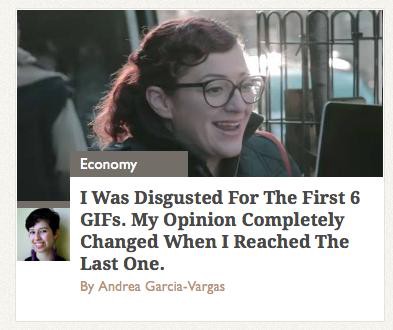
“Some guy you friended eight years ago” is the new internet patois.
Image from the Found Animals Foundation.
The Time I Worked at That Celebrity Bakery
The Time I Worked at That Celebrity Bakery
by Matthew J.X. Malady
People drop things on the Internet and run all the time. So we have to ask. In this edition, Becca Laurie tells us more about some famous people who enjoy eating cupcakes.
@katespencer i worked at a bakery that a lot of celebs liked. i still remember who treated me well (and tipped more than a few pennies)
— Becca Laurie (@imbeccable) August 12, 2014
Becca! So what happened here?
A decade ago, I applied for a bakery job on a whim. I had no experience, and I’d never been to this specific bakery before. I was out to dinner with friends, and we stopped in for dessert. I filled out an application and started training the next week.
The bakery was having a moment: It was featured on a TV show, and that meant a ton of tourists and a handful of celebrities. I worked there for two consecutive summers. By the end of the second year, the hype started to die down, and so did the frequency of famous customers. My memory isn’t as sharp as it used to be, but here’s who I remember:
— Lindsay Lohan, days before she turned eighteen
This was a few months after Mean Girls, and I was so excited to see her. She was wearing a Harley Davidson baseball tee, and I watched her smoke a cigarette in front of the bakery windows.
— Billy Joel and his then-wife
I’m pretty short (5’1). The average person is much taller than me, but not Billy Joel. We were basically at eye level. When most of the adult population is taller than you, seeing eye-to-eye is a rare, intimate experience. We shared a moment. I think he asked about the Magic Cookie Bars. They left without buying anything.
— Billy Crudup and Claire Danes
Billy got a slice of key lime pie. This was a few weeks after their relationship went public, and it felt scandalous! He was really nice, and I remember thinking his choice of dessert fit his personality. He lived in Florida for a while. Maybe he was homesick!
— Mary Kate Olsen
She was also incredibly short. I felt like I towered over her, and I don’t tower over anybody.
— Vanessa Carlton and Stephen Jenkins (from Third Eye Blind)
They came in as the bakery was closing one night, and we had a bunch of leftover cupcakes. If the night was really dead, we would offer extra cupcakes sometimes (otherwise they would go in the trash). I offered an extra cupcake to V and S, and Stephen replied “well, every cupcake is an extra cupcake if you know what I mean.” Ten years later, his response still haunts me.
Which celebrities were the best tippers, and the nicest people?
There were two really memorable experiences. The first was Brittany Murphy. She was so energetic. She was with a friend who had never been to the bakery. Brittany wanted her friend to try everything. She told us that she used to live in the neighborhood and would get a slice of cake on her way home from auditions or work or whatever. I think she got a slice of every cake we sold. One of my coworkers was a struggling actress, and Brittany looked into her eyes and told her to never give up, and that she was destined for good things, because she had a good soul. She was so genuinely kind. She tipped really well.
Pharrell came into the bakery on a rainy September weeknight. He bought two cupcakes (one for him, one for his friend), and paid with his AMEX Black Card. Remember those? They were a big deal in 2004. The total for his order was $3.50. He made a joke about charging such a small amount to the card and left a really big tip. I kept the receipt. Sorry!
Lesson learned (if any)?
Be nice. To strangers, to people you meet, but especially to service industry workers. A little kindness goes a long way.
Just one more thing.
Waiting in line for food of any kind is rarely worth it.
Matthew J.X. Malady is a writer and editor in New York.
A Study in Contrasts
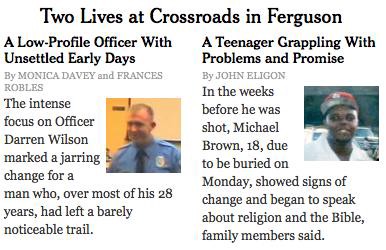
As hundreds line up for Michael Brown’s funeral, the New York Times is running twinned profiles of twenty-eight-year-old Ferguson police officer Darren Wilson and the unarmed eighteen-year-old he shot to death. This is how Wilson’s begins:
On the early afternoon of Feb. 28, 2013, Officer Darren Wilson answered a police call of a suspicious vehicle where, the police said, the occupants might have been making a drug transaction. After a struggle, Officer Wilson subdued the suspect and grabbed his car keys before help arrived, the police said.
A large amount of marijuana was found in the car, the police said, and the 28-year-old suspect now faces seven charges, including possession of marijuana with the intent to distribute and resisting arrest. The incident won Officer Wilson a commendation, presented by the police chief this year as Officer Wilson stood, hands clasped before him, and city officials looked on.
And Brown’s:
It was 1 a.m. and Michael Brown Jr. called his father, his voice trembling. He had seen something overpowering. In the thick gray clouds that lingered from a passing storm this past June, he made out an angel. And he saw Satan chasing the angel and the angel running into the face of God. Mr. Brown was a prankster, so his father and stepmother chuckled at first.
This is how Wilson’s youth is described:
Officer Wilson, who is divorced, was born in Texas but has spent most of his years in these suburbs that surround St. Louis, records show. Family members, friends, colleagues and a lawyer have mostly refused to speak publicly about him, yet those who do paint a portrait of a well-mannered, relatively soft-spoken, even bland person who seemed, if anything, to seek out a low profile — perhaps, some suggested, a reaction to a turbulent youth in which his mother was repeatedly divorced, convicted of financial crimes and died of natural causes before he finished high school in 2004.
“He was a good kid but also a nondescript kid,” said Barney Brinkmann, who coached ice hockey at St. Charles West High School, where some who knew Officer Wilson say he narrowly got enough ice time his senior year to earn a varsity letter.
And Brown’s:
Michael Brown, 18, due to be buried on Monday, was no angel, with public records and interviews with friends and family revealing both problems and promise in his young life. Shortly before his encounter with Officer Wilson, the police say he was caught on a security camera stealing a box of cigars, pushing the clerk of a convenience store into a display case. He lived in a community that had rough patches, and he dabbled in drugs and alcohol. He had taken to rapping in recent months, producing lyrics that were by turns contemplative and vulgar. He got into at least one scuffle with a neighbor.
This is how the personal profile of Wilson comes to a close:
After attending the police academy, Officer Wilson began work in Jennings, another suburb, in June 2009. Robert Orr, the former chief of the Jennings Police Department, said he had no recollection of Officer Wilson and had to call the mayor last week to jog his memory. “Sure enough, the mayor said he was one of ours,” Mr. Orr said. “That must mean he never got in any trouble, because that’s when they usually came to me.”
Yet Officer Wilson’s formative experiences in policing came in a department that wrestled historically with issues of racial tension, mismanagement and turmoil. During Officer Wilson’s brief tenure, another officer was fired for a wrongful shooting, and a lieutenant was accused of stealing federal funds. In 2011, in the wake of federal and state investigations into the misuse of grant money, the department closed, and the city entered into a contract to be policed by the county. The department was found to have used grant money to pay overtime for D.W.I. checkpoints that never took place.
And this is how Brown’s ends:
He was an avid video game player. His favorite games were Call of Duty Zombies and PlayStation Home, a simulation game in which he created an avatar and a city. He was deft with technology and his hands. Once, when his cousin’s PlayStation broke because a disc was stuck in it, Mr. Brown took it apart, fixed it and reassembled it.
Mr. Brown, who constantly wore his Beats by Dre headphones, also was a big fan of rap music. He knew of Kendrick Lamar before he became famous. His favorite group was Migos. And within the past year, he began producing rap songs with friends.
The content varied. He collaborated on songs that included lyrics such as “My favorite part is when the bodies hit the ground.” But he also derided fathers who “don’t pay child support” and rapped glowingly about his stepmother.
He occasionally smoked marijuana and drank alcohol, according to friends. But for his music he adopted a persona to appeal to hip-hop fans, said his cousin, Bryan Douglas, a music producer who was going to help Mr. Brown pursue his music career.
A quiet, undistinguished man who persevered after a troubled upbringing and was perhaps caught up in the wrong department — a victim of the system. A rebellious youth who grew up in a rough neighborhood but had some potential thanks to his family, even though he really just wanted to play video games and rap and smoke pot.
Fifty years ago, a teenager named James Powell was shot and killed by an officer who claimed, contrary to witness accounts, that the boy was charging with a knife. Here is how he was introduced at the time, in the very same paper’s pages:
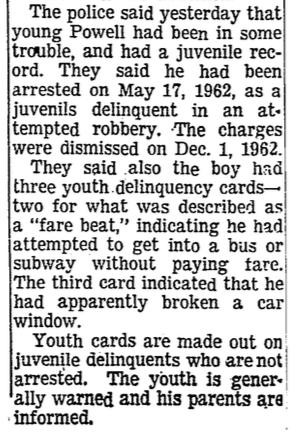
Powell, five decades ago, was at least granted the benefit of “the police said.”
This Week in Lines
by Jake Gallagher
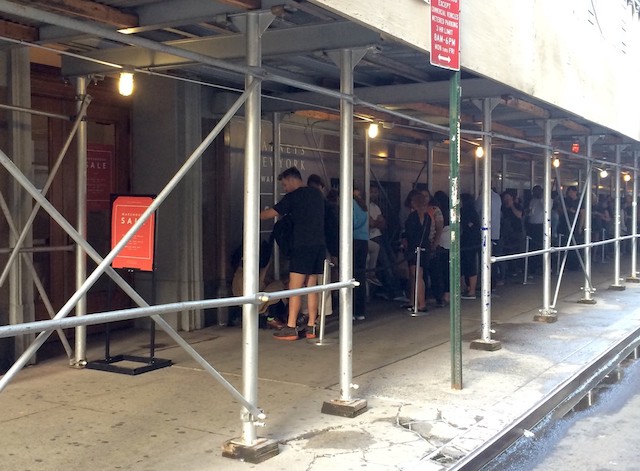
7:55 AM Thursday, August 21 — Barney’s Warehouse Sale, The Metropolitan Pavilion at 19th and 6th
Length: Seventy-six people
Weather: 66 and partly cloudy
Crowd: Under caffeinated clothing addicts
Mood: Half asleep yet fully dressed
Wait Time: Fifteen-to-twenty minutes
Lingering Question: How has this “warehouse” not been cleaned out yet?
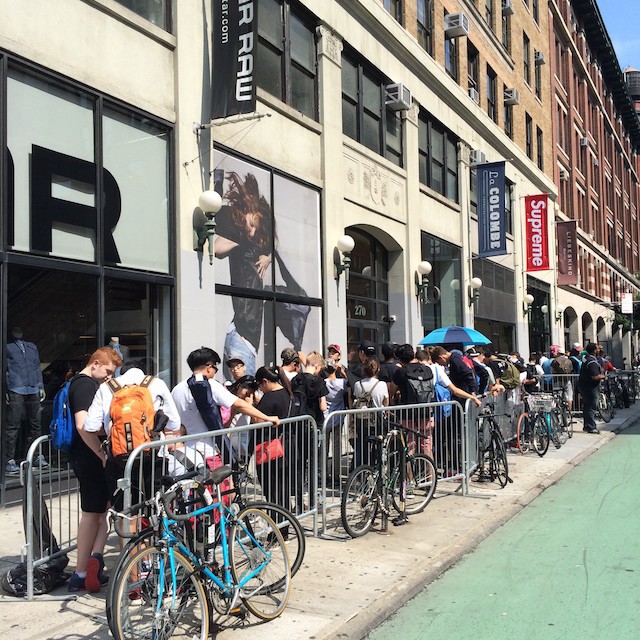
11:15 AM Thursday, August 21st — Supreme New York Fall collection launch, Lafayette and Prince
Length: A hundred and seven boys, two girls
Weather: 75 and cloudy
Crowd: Hypebeasts that can buy all the Nikes they want, but still can’t a beer
Mood: Be-sneakered and self-conscious
Wait time: Two-to-three hours
Lingering question: How many weeks’ allowance does a Supreme hat cost?
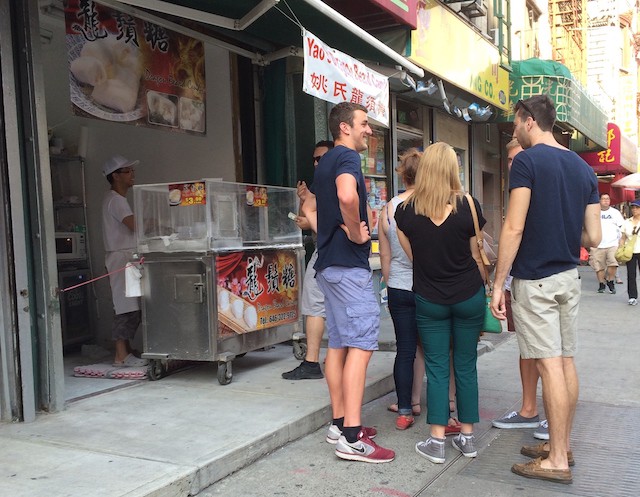
5:32 PM Saturday, August 16th — “Dragon Beard” Candy Stand, Mott and Grand
Length: Seven people
Weather: 77 and partly cloudy
Crowd: Wide-eyed European tourists
Mood: Skeptical yet undeniably intrigued
Wait time: Five minutes
Lingering Question: What exactly is a Dragon Beard and why would anyone want to consume it?
Jake Gallagher is a writer for A Continuous Lean and other places.
Bethany Beach, Delaware, August 21, 2014

★★★★★ White haze surrounded the sun. The forecast of showers — deferred so many days now — seemed plausible for the first time. The story-time room at the library, into which the children had stumbled, unwitting, was chilly with air conditioning but humid nonetheless. Conditions were more comfortable out in the slatted shade of the library garden, bordered by roses and planted with dark purple foliage. Toward midday, two age-thickened men contemplated their motorcycles. A gigantic insect, near hummingbird size, flew among the branches of a pine. Down at the shore, the air was perfect, the sun cut by clouds passing. The water too was ideal. Big swells dipped to reveal a white ship far off, then rose to obstruct the view of the ship, then rose even higher as the first obstruction passed and the trough descended. Gulls gathered just above the waves, clustering and stabbing at the water; pelicans flew by low. The whole surface was rimpled, the sides of the wavelets roughened by their own little disturbances. Off to the north, parallel lines of blurry gray stretched from inland out to sea, but the brightness remained nearby. Fine misty spray shone above the usual splashing. The ocean carried the body and absorbed the mind. One hundred fifty yards, nearly two hundred, slid away. The walk back to the beach chairs was so long it seemed as if some mistake must have been made. A sanderling, bone-white streaked with black, ran on the wetted sands. People had built sand castles and embankments, and the tide advanced on them. The two-year-old edged out onto the last of the dry sand, then agreed to try the foam. Minutes later he was dangling in the full frothing surf, suspended by his armpits, kicking and splashing in wild defiance of or identification with the rushing waters. He yelled at the sea, his shirt wet past the chest. Even the hike up the back of the beach, the usually hot and tedious expanse of sand, was comfortable. The sky grayed over, till sunset was nothing but a darkening. Wrens chattered with a harsh insectoid rattle at a cat in their shrubbery. The surf at dusk boomed like incipient thunderstorms. Deep in the night, the real thunder came, and white lightning.
